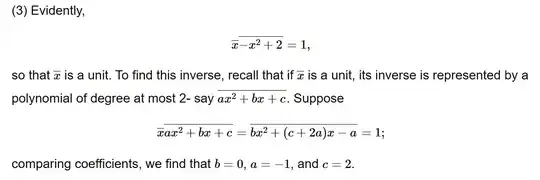Here is the question I am trying to understand the solution of letter $(c)$ in it:
Let $x^3 - 2x + 1$ be an element of the polynomial ring $E = \mathbb Z[x]$ and use the bar notation to denote the passage to the quotient ring $\mathbb Z[x]/(x^3 - 2x + 1).$ Let $p(x) = 2x^7 - 7x^5 + 4x^3 - 9x + 1$ and let $q(x) = (x - 1)^4.$\
$(a)$ Express each of the following elements of $\overline E$ in the form $\overline{f(x)}$ for some polynomial $f(x)$ of degree $\leq 2: \overline{p(x)}, \overline{q(x)}, \overline{p(x) + q(x)}$ and $\overline{p(x)q(x)}.$
$(b)$ Prove that $\overline{E}$ is not an integral domain.
$(c)$ Prove that $\overline{x}$ is a unit in $\overline{E}$.
Here is the solution I found online here https://linearalgebras.com/solution-abstract-algebra-exercise-7-4-17.html:
My question is:
Why the inverse of $\bar{x}$ should be of degree at most 2, could someone clarify this to me please?
